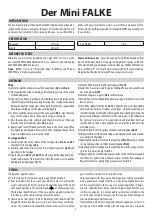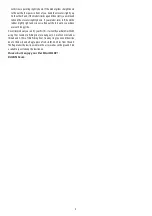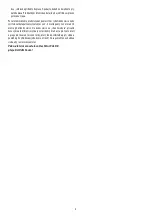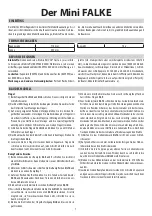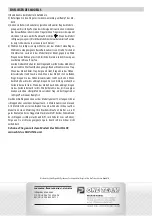
3
Der Mini FALKE
INTRODUCTION
The hand launch glider (HLG) Der Mini FALKE (Mini Falcon) has been de-
signed with beginners looking for their very first model in mind. You will
need some basic modeller‘s tools, glues and dopes – you will find these
handy with any of your future projects as well. Please make yourself fa-
miliar with the building plans and this manual BEFORE you actually start
the assembly.
SPECIFICATION
Wingspan
710 mm
Length
505 mm
All-up Weight
70 g
BEFORE YOU START
Glue:
You can use solvent based modeller‘s glue (UHU® Hart etc.), medi-
um cyano (KAV9952 KAVAN Medium CA etc.) or water resistant white glue
(KAV9960 KAVAN White Glue etc.).
Dope:
KAVAN Classic line Protective Dope (KAV9988) and Thinner
(KAV9990) are highly recommended.
Tools and Accessories:
You will need a perfectly flat building board (at
least 150x700 mm), builder’s triangle, sanding blocks/sponges with 180-
200 and 360-400 grit sandpaper, model hobby pins (KAV0355 Modeller‘s
Pins), soft flat (1/4“-3/8”) brush, thin clear plastic film to protect the buil-
ding plan/building board (a large PE bag cut open will work)..
ASSEMBLY
Wing
1) Carefully sand the entire surface of the wing halves
No.1
and
No.2
.
2) Glue together the wing assembly jig following the picture in the centre
of the building plan.
3) Glue the wing halves together on a flat building board protected with a
sheet of thin plastic film preventing the wing from sticking to the board.
Pin down one of the wing halves; then attach the other one supported by
the wing assembly jig. Let the glue cure thoroughly.
4) Carefully sand the entire surface of the wing panels
No.3
. Glue them one
by one to the wing centre section using the wing assembly jig.
5) Once the glue has cured, carefully sand the entire surface of the wing.
Glue the wing reinforcement plate
No.4
in place.
6) Apply a light coat of thinned protective dope to the entire wing. When
dry, lightly sand all doped surfaces with the fine sandpaper. Repeat twice
more; sand lightly once every coat has dried.
Fuselage and Tail
1) Carefully sand the entire surface of the fuselage sides
No.5
and
No.7
.
Glue them to the fuselage
No.6
.
2) Carefully sand the entire surface of the tail boom longerons
No.10
and
glue them to the fuselage.
3) Glue the fin parts
No.12
and
No.13
together on a flat building board pro-
tected with a sheet of thin plastic film. Once the glue has set, round the
leading and trailing edge of the fin.
4) Glue the fin between the tail boom longerons
No.10
.
5) Sand to fit if necessary and then glue the
No.11
brace between the tail
boom longerons
No.10
.
6) Glue the wing seat supports
No.8
to the fuselage.
7) Drill out the hole for the
No.9
wing dowel using 3 mm drill bit; insert the
dowel in place.
8) Cut off the rudder from the fin
No.12
. The dashed lines on the building
plan mark the position of rudder wire hinges. Stick the modelling pin
into the front edge of the rudder. Enlarge the hole slightly by twirling the
pin carefully. Make the other holes for the wire hinges in the rudder and
fin. Cut two 8 mm pieces of the supplied wire and glue them half-way
into the holes in the fin. Once the glue has set, glue the rudder onto the
protruding wires.
9) Carefully sand the entire surface of the horizontal tailplane
No.14
.
10) Prepare and install the elevator hinges and elevator in the same manner
as you did with the rudder.
11) Bevel lightly the sides of tabs on the top of the fin
No.13
in order to fit the
corresponding notches in the horizontal tailplane
No.14
.
12) Glue the horizontal tailplane on the top of the fin; use the wing assembly
jig to be sure it was square to the fin.
13) Apply a light coat of thinned protective dope to the entire fuselage and
tail. When dry, lightly sand all doped surfaces with the fine sandpaper.
Repeat twice more; sand lightly once every coat has dried.
FLYING
1) Apply the supplied stickers.
2) Tie the wing to the fuselage using the supplied rubber band.
3) Pour the ballast into the nose of your model in order to achieve the
correct Centre of gravity (CG) position. Support the wing of the model
with your fingertips in the point marked „
“ on the fuselage plan.
The fuselage should be level - if the nose pitches up, add more ballast
into the nose; if the tails pitches up remove the ballast.
4) Choose a nice calm day for the first flight of your Der Mini FALKE. The
flying field should be a flat, grassy site; free of power lines or other ob-
stacles. The model must be launched into the wind every time. Throw
grass into the air to observe the wind direction.
Hold your model with the wings and fuselage level. Launch your model
with a gentle push straight with the nose pointing slightly down. Do
not throw your model with nose up, or at greater angle than 10 degre-
es down. The model must have a certain minimum speed from the very
start to stay airborne. It is not enough to just place your model in the
air. It is better to land in tall grass in order to prevent any damage to
your model during initial trimming.
If everything is OK (correct wing and tailplane alignment, correct CG
position), Der Mini FALKE will fly with the wings level in a nice glide



